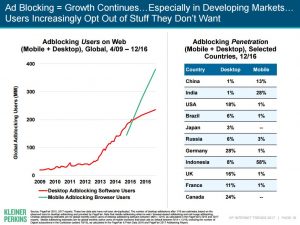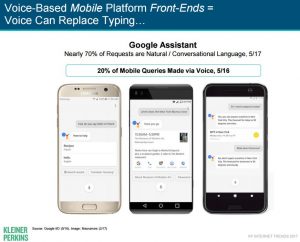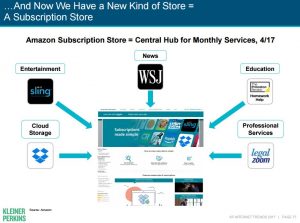Mary Meeker’s 2017 Internet Trends report is out, and it packs a punch.
In addition to providing an overview, the slides cover eight key topics:
- online advertising
- interactive games (including product innovation & modern learning)
- media (distributed disruption at a torrid pace)
- the cloud (accelerating change across enterprises)
- China’s Internet
- India’s Internet
- health care
- global public/private Internet companies
Reading through the 355-slide report is a bit like going to multiple art exhibits in one day — your brain (well, my brain) just can’t absorb Rembrandt and Picasso back-to-back. And I won’t make you either.
Thus I present just four takeaways, on online advertising and commerce, from Meeker’s 2017 Internet Trends.
I’m gonna just say no.

I love that the Android operating system on my Google Pixel identifies incoming telemarketing phone calls. The screen goes “warning red,” and I swipe to block the call. We’re doing the same online. Consumers, especially in the U.S., the U.K, and Canada, are increasingly adopting ad blockers to opt out of content we don’t want. While online advertising is still a big deal, it has to be contextual and goal-driven.
The future of advertising is us.

We’re the data points, so we might as well be the ad points too. One way to achieve this? User-generated content. From Sephora to Turkish Airlines, companies are finding ways to use our content to build brand awareness for their products and services. This is about both the things we (as consumers) tag and with how companies can create strategies to help us “tag them in.” Meeker also has several slides about how “the content = the store.” The more you can integrate user content and deploy seamless ad-to-sale technology, the better.
Voice search is growing.

I’ve been talking about voice search for several years, including pointing out last year the growing importance of voice recognition. Just look at one statistic: that 20 percent of mobile queries are made by voice. This means that keywords will become less important unless you’re a very weird person who searches for “pizza,” “vegetarian,” “Washington, DC.” No? It’s not too early to think about how to optimize your content for the way that people talk.
The subscription store is here.

We are living in the subscription service age. Zip Cars. Netflix. Freshly. Need I say more?
I get my workouts (DailyBurn), my music (Spotify), and a good amount of my baseball (MLB.TV) via subscription. And that doesn’t even factor in the business-related services I subscribe to, including Google Apps, Buffer, LastPass, and even Microsoft Office. So far I’ve purchased everything piecemeal — and you probably have too. But imagine you’re changing jobs or moving into a new house, and you need to set up a bunch of new services. Wouldn’t it be nice to go to one site and point-click-buy everything? (Or maybe Amazon is all we need?)
In her 2017 Internet Trends report, Meeker has this lone slide on the birth of the subscription store. She’s picking up on the idea of turning subscription commerce into a one-stop shop. Is there a way for your business to take this concept in some form and run with it?
Feature photo by James Pond.



